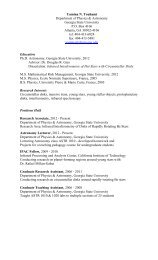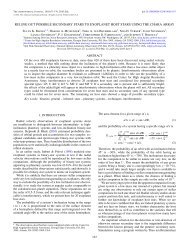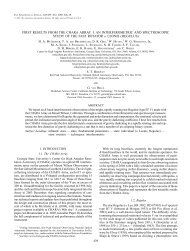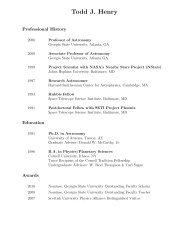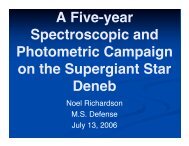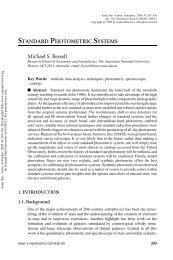Optical Coatings for CHARA Reflective Optics - GSU Astronomy ...
Optical Coatings for CHARA Reflective Optics - GSU Astronomy ...
Optical Coatings for CHARA Reflective Optics - GSU Astronomy ...
You also want an ePaper? Increase the reach of your titles
YUMPU automatically turns print PDFs into web optimized ePapers that Google loves.
<strong>Reflective</strong> <strong>Optics</strong>Some manufacturers indicate that their coatings pass the MIL-SPEC MIL-M-13508C. Thisincludes the following: exposure to 95+% relative humidity <strong>for</strong> 24 hours with no evidence ofpitting or corrosion; 50 strokes with a cheesecloth with no sign of deterioration; five hours at -80 o F and 5 hours at 160 o F with no signs of deterioration; and a cellulose tape test with no partof coating removed. These show that the coating is not mechanically fragile.The protected silver can still be attacked (probably by moisture containing sulfur) throughpinholes in the protective coating, and from the edges of the coating. There have beenanecdotal reports that some substrates can promote coating degradation, perhaps from internalimpurities.Although some of the coating options appear to offer reasonable certainty of long or evenindefinite life, the possibility of eventual recoating must be considered. The features that makeprotected silver protected also make it difficult to remove. Obnoxious processes such as use ofhot sulfuric acid (!) have been mentioned. Some vendors do not know how to remove theircoatings and simply say that substrates must be re-polished be<strong>for</strong>e recoating.10. PROTECTION OF SILVER COATINGSEven protected silver coatings are not expected to last <strong>for</strong>ever. However, there have beenin<strong>for</strong>mal reports of some coatings having a lifetime of only 1-2 years. Usually these reportsare associated with a particular vendor's products. It is probably difficult to draw anyconclusions from anecdotal evidence (other than a need <strong>for</strong> caution) due to variations insubstrate characteristics, handling and operating environment.The process of applying thin film coatings involves a considerable number of parameters.There is preparation of the substrate; the ambient pressure, the cleanliness of the chamber andthe purity of coating material, which will impact presence of impurities; the means ofevaporation, which determine the density and speed of the application; and the temperature ofthe substrate and the options of ion or electron beam assist, which affect how the film adheresand crystallizes. Even experienced vendors do test runs to re-verify their setup and techniquebe<strong>for</strong>e each production run series. Much of the process is more in the nature of an art than ascience, and it would not be surprising if some vendors had evolved significantly superiorskills.Damage to optical surfaces often involves the deposition of dust. Ambient humiditycontributes a moisture content to the dust, and the liquid provides a medium <strong>for</strong> reactions onthe optical material of bases (typical southwestern alkali dust), or acid (fumes from internalcombustion engines). Hence a major step in protecting optics is preventing deposition of dust,and controlling humidity. This suggests the value of dust covers, with the importance growingrapidly in the more exposed areas. Some optical surfaces can be cleaned. This option shouldbe thoroughly understood and implemented as feasible. Control of air moisture content, wherepossible, is also advisable, especially avoiding the very high levels sometimes encountered inthe winter.7



